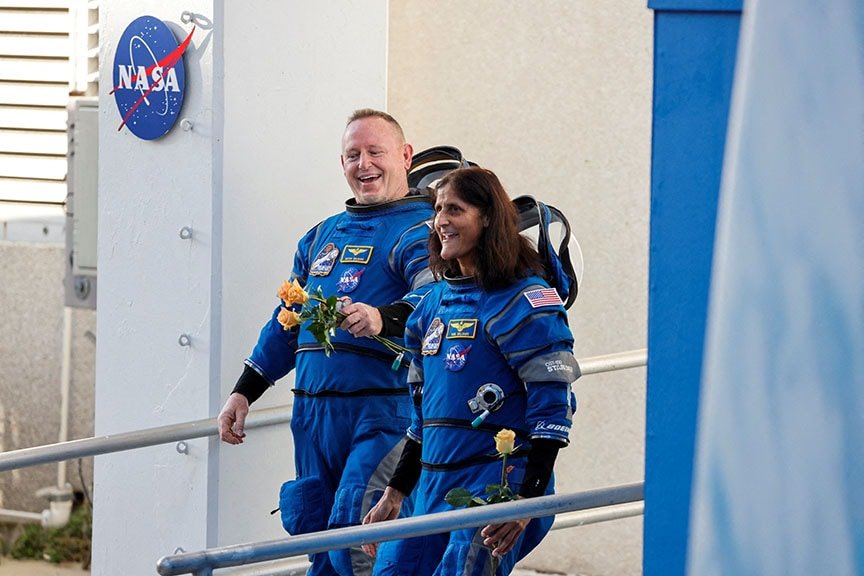Introduction
Indian-origin astronaut Sunita Williams is facing an unexpected extension of her mission aboard the International Space Station (ISS) due to Sunita Williams Stuck and delay in the return flight of the Boeing Starliner spacecraft. Initially scheduled to return on June 14, and later postponed to June 26, the mission has encountered further setbacks, with NASA citing the need for more time to review technical issues with the spacecraft.
The Delayed Return
NASA has not provided a new date for the Starliner’s return, which has raised concerns and questions about the timing of Williams and her fellow astronaut Butch Wilmore’s return to Earth. The return flight was delay in part due to planned spacewalks on June 24 and July 2, which required mission managers to evaluate future return opportunities.
“Mission managers are evaluating future return opportunities following the station’s two planned spacewalks on June 24 and July 2,” NASA stated. Steve Stich, NASA’s commercial crew program manager, emphasized that they are taking their time and following the standard mission management process. He also noted that the Starliner is performing well in orbit and that the extended time in space could provide valuable insights for future system upgrades.
Technical Challenges and Previous Test Flights
The Sunita Williams Stuck delay is largely attribute to technical issues encountered by the Starliner. In its previous test flights, the spacecraft faced significant challenges, including failures in five of its 28 maneuvering thrusters, helium gas leaks, and a slow-moving propellant valve. Despite these issues, the decision was made to proceed with the current mission, albeit with close monitoring and ongoing evaluations.
The most recent delay was cause by a helium leak detect on the Starliner. Reports indicate that both NASA and Boeing managers were aware of the leak before the launch but deemed it too small to jeopardize the mission. However, the development of additional leaks in orbit and the failure of one thruster have compounded the challenges, leaving Sunita Williams stuck in space for longer than anticipated.
Implications for Boeing and NASA
Boeing has invested nearly $1.5 billion in cost overruns beyond its $4.5 billion contract with NASA to develop the Starliner. The successful completion of this mission is crucial for Boeing, as it would establish them as the second company capable of ferrying astronauts to the ISS, alongside SpaceX’s Crew Dragon, which has been the primary ride to the ISS since 2020.

The ongoing delays and technical issues have put Boeing under intense scrutiny. The company has faced criticism for its handling of the Starliner program, adding to the challenges it has faced following high-profile malfunctions in its aircraft division. At least 20 whistleblowers have raised concerns about safety and quality issues at Boeing, further tarnishing its reputation in the aerospace industry.
Current Status and Future Prospects
As of now, NASA has not set a new return date for Sunita Williams and Butch Wilmore. The uncertainty surrounding the Starliner’s return has led to speculation about the future of the spacecraft and Boeing’s role in NASA’s commercial crew program. While officials assert that the astronauts are not strand and can return to Earth if necessary, the ongoing tests and evaluations raise doubts about the Starliner’s readiness for a safe return trip.
NASA and Boeing are working closely to address the issues and ensure the safety of the astronauts. Stich mention that engineers are given as much time as possible to review telemetry, conduct tests, and prepare contingency plans for any additional problems that might arise after undocking.
Broader Context and Public Perception
The delays and technical challenges faced by the Starliner are part of a broader context of rigorous testing and high standards in space missions. While such delays are not uncommon in space exploration, the extended mission has garnered significant attention due to the high-profile nature of the astronauts involved and the competition between Boeing and SpaceX.

Public perception of NASA and Boeing is affect by the delays. The aerospace community and the general public are keenly watching the developments, with many expressing concerns over the safety and reliability of the Starliner. NASA’s transparent communication and emphasis on safety have been crucial in maintaining trust, but the repeated delays highlight the complexities and risks inherent in space travel.
The Personal Impact on Sunita Williams and Butch Wilmore
For Sunita Williams and Butch Wilmore, the extended stay at the ISS means more time conducting experiments, performing maintenance, and supporting ongoing missions. Both astronauts are experienced and have expressed confidence in the mission’s management. However, the extended duration also means more time away from their families and the challenges of adapting to prolonged life in microgravity.
Williams, an experienced astronaut with previous long-duration missions, has been resilient in facing these challenges. Her experience and professionalism are invaluable in navigating the uncertainties and ensuring the success of the mission despite the delays.

Conclusion
The situation of Sunita Williams stuck in space due to the delayed return of the Boeing Starliner highlights the complexities and challenges of modern space exploration. While the delays are frustrating and raise questions about the future of the Starliner program, they also underscore the importance of rigorous testing and safety protocols in ensuring the success and safety of space missions.
Also Read: Sonakshi Sinha Marriage: A Celebration of Love and Togetherness
As NASA and Boeing continue to address the technical issues and prepare for a safe return, the extended mission provides valuable insights and data that will benefit future missions. The resilience and professionalism of astronauts like Sunita Williams and Butch Wilmore are a testament to the dedication and expertise required in the pursuit of space exploration.









